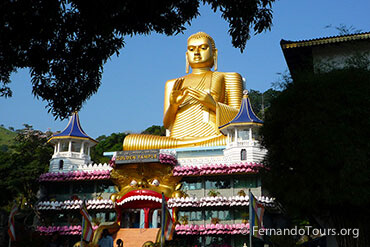The Dambulla Cave Temple, also known as the Golden Temple of Dambulla, is a UNESCO World Heritage Site in Sri Lanka. It is located in the central part of the country, near the town of Dambulla. The temple complex is renowned for its ancient cave temples, stunning murals, and numerous Buddha statues. Here are some key features and information about the Dambulla Cave Temple:
1. Historical Significance: The Dambulla Cave Temple has a history that dates back to the 1st century BCE when King Valagamba took refuge in these caves during an invasion. After regaining his throne, he converted the caves into a rock temple.
2. Cave Complex: The temple complex consists of five caves that are carved into a large granite rock. These caves are interconnected and house a vast collection of Buddhist murals, sculptures, and statues.
3. Buddha Statues: The caves contain over 150 statues of Buddha in various poses and sizes. The largest and most impressive is a 14-meter long reclining Buddha statue in the first cave.
4. Wall Paintings: The interiors of the caves are adorned with intricate and well-preserved ancient frescoes that depict scenes from the life of Buddha, as well as various deities and historical events.
5. Cave Names and Themes:
– Cave 1: The Devaraja Lena (Cave of the Divine King) features a 14-meter long reclining Buddha statue.
– Cave 2: The Maharaja Lena (Cave of the Great Kings) contains statues of standing and seated Buddhas.
– Cave 3: The Maha Alut Viharaya (Great New Temple) features a stupa and various seated Buddha statues.
– Cave 4: The Pachima Viharaya (Western Temple) includes a large statue of the meditating Buddha.
– Cave 5: The Devana Alut Viharaya (Second New Temple) houses various Buddha statues and paintings.
6. Golden Temple: The exterior of the caves and the surrounding area are adorned with a golden facade, giving the temple its nickname, the “Golden Temple of Dambulla.”
7. Cultural Importance: The Dambulla Cave Temple is a significant pilgrimage site for Buddhists and is considered one of the most well-preserved cave temple complexes in Sri Lanka.
8. UNESCO World Heritage Site: In 1991, the Dambulla Cave Temple was designated as a UNESCO World Heritage Site in recognition of its cultural, archaeological, and artistic significance.
9. Visitor Facilities: The site has facilities for visitors, including a museum that provides more information about the history and significance of the temple complex.
Visiting the Dambulla Cave Temple offers not only a spiritual experience but also an opportunity to admire the ancient art and architecture that has been preserved for centuries. The site attracts both pilgrims and tourists interested in Sri Lanka’s rich cultural heritage.
Kindly be advised that there is an entrance fee for visiting The Dambulla Cave Temple.
